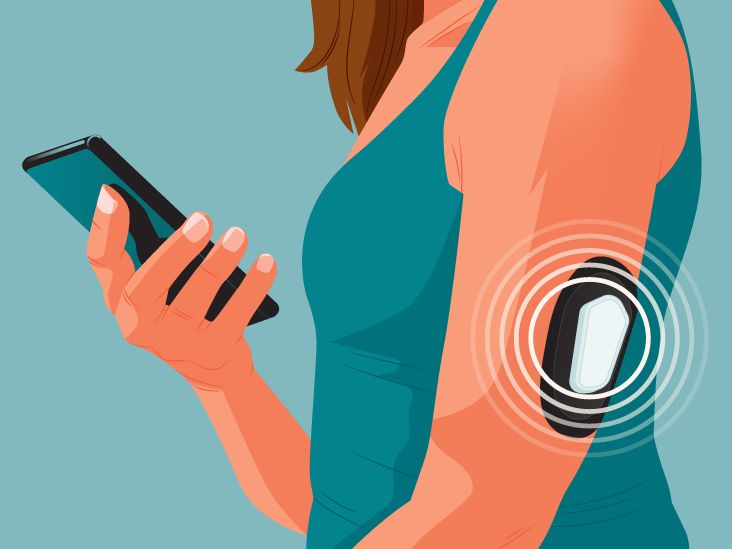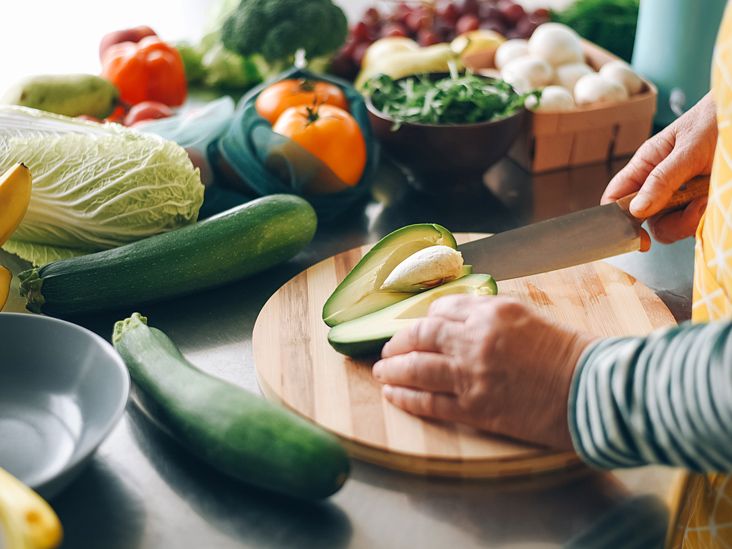Prediabetes doesn’t have to develop into type 2 diabetes. Eating plenty of fiber, monitoring carb intake, limiting portion sizes, and other habits can help keep blood sugar levels within a healthy range.
Prediabetes is characterized by higher-than-normal fasting blood sugar or higher-than-normal blood sugar after eating. It’s most often the result of insulin resistance, a state in which the body doesn’t use the hormone insulin properly.
People with prediabetes are at an increased risk of developing type 2 diabetes and may also be at risk of developing cardiovascular disease.
A diagnosis of prediabetes doesn’t mean you’ll definitely develop type 2 diabetes. The key is early intervention to get your blood sugar levels out of the prediabetes range.
In prediabetes, sugar from food begins to build up in your bloodstream because insulin can’t easily move the sugar into your cells.
The amount and type of carbohydrates you consume through food influence your blood sugar. A diet filled with refined and processed carbohydrates that your body digests quickly can cause higher spikes in blood sugar.
If you have prediabetes, your body likely has a difficult time lowering your blood sugar levels after meals. Watching your carb intake can help you avoid blood sugar spikes.
Fiber offers several benefits. It helps you feel full longer. It also adds bulk to your diet, making bowel movements easier to pass.
Eating fiber-rich foods can make you less likely to overeat and help you avoid the “crash” that can come from eating a high sugar food. High sugar foods will often give you a big boost of energy but make you feel tired shortly afterward.
Examples of high fiber foods include:
- beans and legumes
- fruits and vegetables that have an edible skin
- whole grains such as quinoa and barley
- whole grain breads and cereals
- whole wheat pasta
The glycemic index (GI) is a tool you can use to determine how a particular food could affect your blood sugar.
In general, foods that have a high GI will raise your blood sugar faster. Foods with a lower GI have less of an effect on your blood sugar.
However, different people’s bodies may process these foods differently. Additionally, cooking a food or eating it along with protein or fat can change its GI.
It’s also important to be mindful of portion sizes. Eating a large amount of any carbohydrate-containing food can cause your blood sugar levels to rise.
Low GI foods
Foods that have a low GI, such as high fiber foods, are best for your blood sugar.
Consider incorporating the following items into your eating plan:
- non-starchy vegetables such as carrots and leafy greens
- beans
- sweet potatoes
- nuts and seeds
Food and nutrition labels don’t mention the GI of a given food.
Instead, take note of the fiber content listed on the label in order to determine a food’s GI ranking. Added sugar and ingredients such as white flour can also add to the GI ranking, so looking for foods that have fewer of these on the nutrition label can help you choose lower GI foods.
Medium GI foods
Foods that rank in the medium range on the GI are fine to eat if you have prediabetes, although it’s important to keep portions to
Examples include:
- corn
- brown rice
- whole wheat bread
- steel-cut oats (as opposed to instant oatmeal)
- stone-ground whole wheat bread
- pasta, preferably whole wheat
Keep in mind that brown rice, wheat pasta, and wheat bread typically only have 1 or 2 grams (g) more fiber than white rice, white pasta, and white bread. For this reason, it’s still important to limit your portions of these foods.
High GI foods
Foods that are refined, processed, and lacking in fiber and other nutrients register high on the GI scale.
Refined carbohydrates are one example. These are products, mostly grains or sugars, that digest quickly in your stomach. Some examples are:
- white bread
- russet potatoes (although eating the skin may lower the GI)
- sugar-sweetened soda
- juice
If you have prediabetes, it’s important to limit these foods and drinks.
Eating mixed meals is a great way to lower a food’s GI. For example, if you plan to eat white rice, adding vegetables and chicken cooked in a small amount of healthy fat can slow down the digestion of the grain and minimize blood sugar spikes.
Paying attention to portion sizes can help you keep your diet low on the GI scale.
Often, portion sizes in the United States are much larger than intended serving sizes. Food labels can help you determine how much you’re actually eating. The label will list calories, fat, carbohydrates, and other nutritional information for a particular serving.
If you eat more than the serving listed, it’s important to understand how that will affect the nutritional value. A food may have 20 g of carbohydrates and 150 calories per serving. If you have 2 servings, you’ll consume 40 g of carbohydrates and 300 calories.
However, it’s not necessary to eliminate carbohydrates entirely.
A large
The study noted minimal risk when people consumed a moderate amount of carbohydrates (50% to 55% carbs in a day). On a 1,600-calorie diet, this would equal 200 to 220 g of carbohydrates daily.
This is in line with the Dietary Guidelines for Americans’ recommendation to consume
Your carbohydrate needs vary based on your stature and activity level. If possible, consult a registered dietitian to discuss your specific needs.
Mindful eating
One of the best ways to manage portions is to practice mindful eating. This may help you become more aware of your hunger levels and when you’re becoming full.
Mindful eating involves doing the following as much as possible:
- sitting while you eat
- not eating while distracted by a TV or another screen
- focusing on the food and flavors
- eating slowly
Meat doesn’t contain carbohydrates, but it can be a significant source of fat in your diet. Eating a lot of unhealthy fats can lead to prediabetes as well as high cholesterol and heart disease.
If you have prediabetes, eating a diet low in saturated fat and trans fat can help reduce your risk of developing heart disease.
Choose higher protein and fiber sources such as the following:
- beans and legume
- soybean products, such as tofu and tempeh
- low fat Greek yogurt
- eggs
- chicken
- turkey
- fish, such as cod, flounder, haddock, halibut, tuna, and trout
- shellfish, such as crab, lobster, shrimp, and scallops
- lean beef cuts, such as flank steak, ground round, tenderloin, and roast with the fat trimmed
Be mindful that even foods such as beans, legumes, and Greek yogurt still have carbs. Make sure you’re reading the full nutrition label to understand the carb counts for what you’re consuming.
Cooking chicken or turkey with the skin on will preserve moisture and have little effect on the fat content. However, it’s important to remove the skin before eating.
Avoid cuts of meat, such as beef, that have visible fat or skin.
Moderation is a healthy rule to live by in most instances. Drinking alcohol is no exception.
Many alcoholic beverages are dehydrating. In addition, some cocktails may contain high amounts of sugar, which can cause blood sugar spikes.
According to the
The following are the measurements for an average single drink:
- 1 bottle of beer = 12 fluid ounces (fl oz)
- 1 glass of wine = 5 fl oz
- 1 shot of distilled spirits, such as gin, vodka, or whiskey = 1.5 fl oz
Keep your drink as simple as possible, and avoid adding soda, sugary juices or liqueurs.
Also, keep a glass of water nearby that you can sip on to prevent dehydration.
Water is an important part of any healthy diet. It’s important to drink enough water each day to prevent dehydration.
If you have prediabetes, water is a healthier option than sugary sodas, juices, or energy drinks. These beverages typically contain calories that translate to quick-digesting carbohydrates and have little or no other nutritional value.
A single 12-oz can of regular soda may contain around 40 g of carbohydrates. Water is a better choice to quench your thirst. For variety, you can use lemon, lime, orange, or cucumber slices or mint to help flavor the water.
The amount of water you should drink every day depends on your body size, your activity level, and the climate you live in.
You can determine whether you’re drinking enough water by monitoring the volume of urine when you go. Take note of the color as well. Urine should usually be pale yellow.
Exercise is a part of any healthy lifestyle. It’s especially important if you have prediabetes.
A lack of physical activity
The
- 150 to 300 minutes of moderate intensity aerobic activity per week or
- 75 to 150 minutes of vigorous intensity aerobic activity per week or
- an equivalent combination of moderate and vigorous intensity aerobic activity each week
Also, to maintain muscle mass, try adding a session of resistance exercise, such as stretch bands, hand weights, or isometrics, two to three times per week.
Exercise doesn’t have to be overly complicated. Consider walking, dancing, riding a bicycle, or any other physical activity you enjoy. Chair exercise is a great option for those with limited mobility.
The American Diabetes Association’s Standards of Care also note the importance of physical activity for people with prediabetes or diabetes.
An active lifestyle may prevent a person with prediabetes from developing type 2 diabetes and help a person with diabetes manage their blood sugar levels.
One of the ADA’s recommendations states that adults should avoid sitting for more than 30 minutes at a time. You may want to try breaking up your sitting time by doing a few squats, toe raises, or knee raises.
Your eating habits play a key role in prediabetes management and may help prevent type 2 diabetes from developing.
If you’ve received a diagnosis of prediabetes, you and your doctor can develop an eating plan that works best for you.











